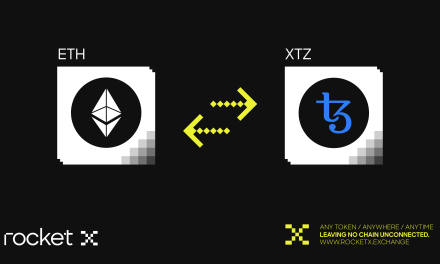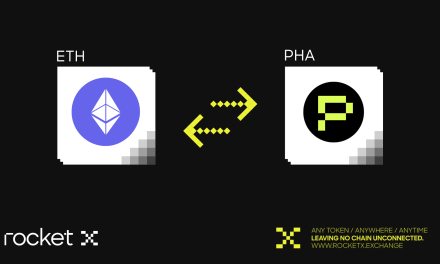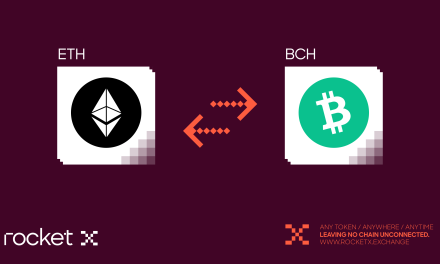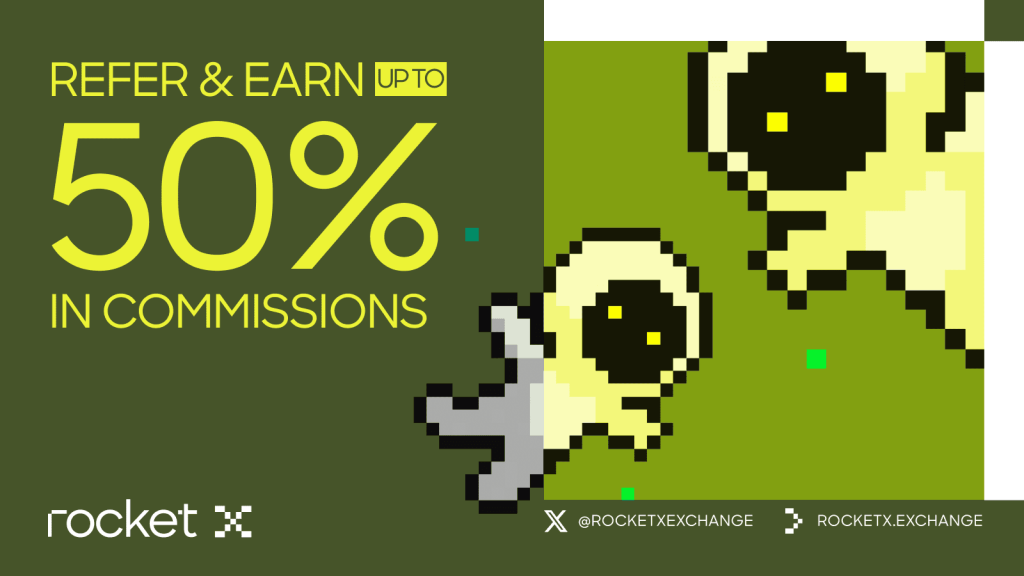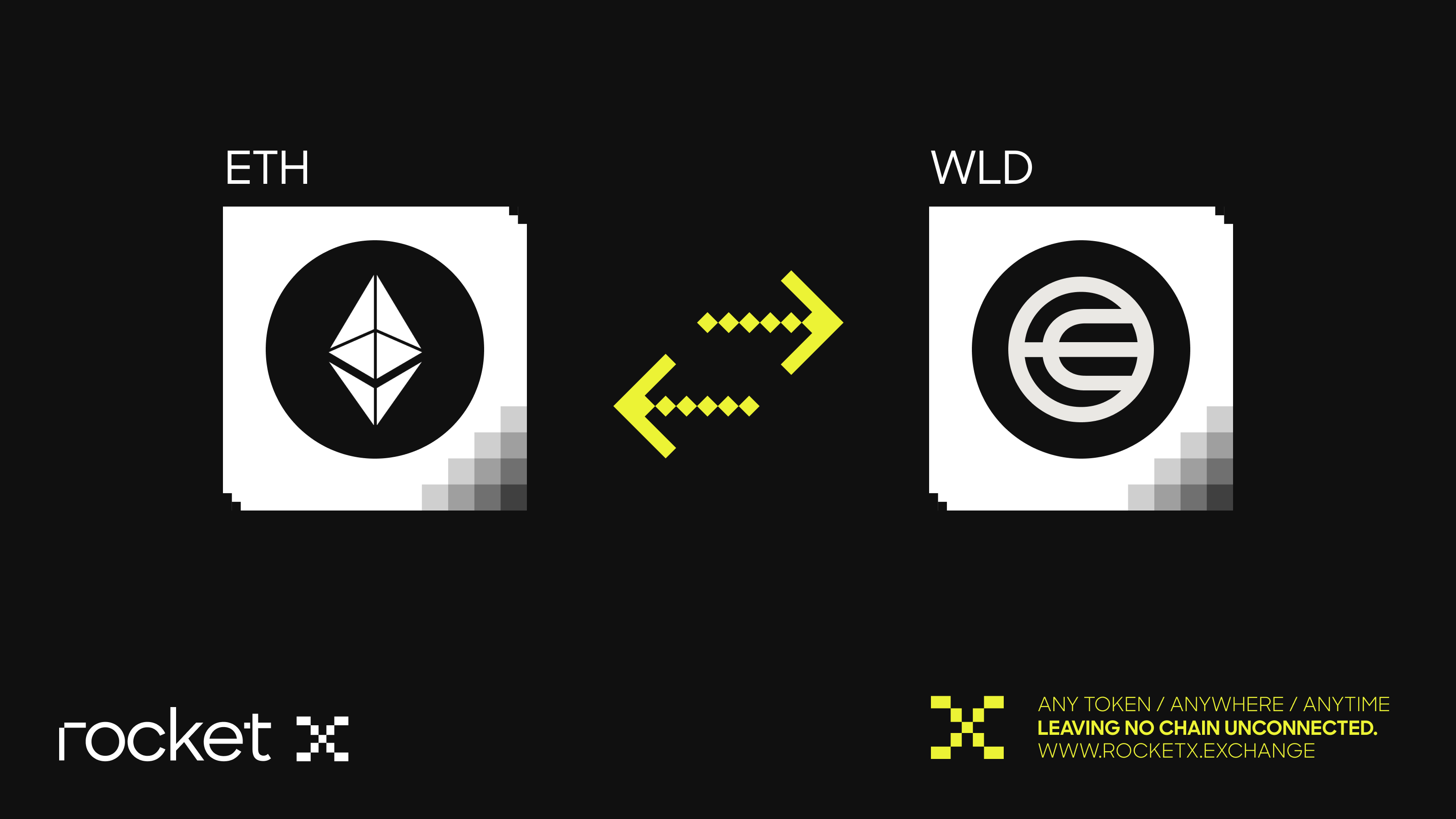
Introduction
In today’s digital landscape, distinguishing real human users from bots has become increasingly difficult. The explosion of fake accounts, AI-generated identities, and spammy behavior has eroded trust across online platforms. This is where World Chain emerges as a powerful solution to this growing problem, designed to bring authenticity, security, and human verification to the forefront of Web3. By integrating biometric verification with blockchain technology, World Chain strives to establish a secure, inclusive, and decentralized platform that prioritizes human identity and participation.
In this article, we’ll explore what World Chain is, key technical features, the vision behind its creation, the role of Worldcoin (WLD) with use cases, and how you can bridge funds to World Chain. Let’s dive in.
Understanding World Chain: A Blockchain Built for Humans
World Chain is a Layer-2 blockchain built on the Optimism OP Stack, designed to prioritize verified human users over bots and AI. Integrated with World ID—a biometric identity system that uses iris scans for proof-of-personhood—World Chain ensures every participant is uniquely human. It offers faster, low-cost transactions while maintaining Ethereum’s security.
The blockchain was co-founded by Sam Altman (CEO of OpenAI), Alex Blania, and Max Novendstern. Initially launched under the Worldcoin brand, the project has now evolved into “World,” with World Chain, World ID, World App, and Worldcoin forming its core pillars.
Their mission? To build a human-centric digital ecosystem that combats AI-driven fraud and empowers real users worldwide with identity, access, and financial tools. With a focus on decentralization and privacy, World Chain is reshaping how we prove our humanity on-chain.
Key Features of World Chain
World Chain is packed with features that set it apart from traditional blockchain networks—its design is rooted in human verification, affordability, scalability, and inclusive governance.
Proof-of-Personhood with World ID: World Chain integrates World ID, a biometric identity system that uses iris scans to verify users as unique humans. This ensures that interactions on the blockchain—whether voting, transacting, or accessing services—are performed by real people, not bots or duplicate accounts. By embedding this proof-of-personhood, World Chain reduces fraud, spam, and manipulation, creating a trustworthy environment for applications like decentralized governance or reward systems. For example, if a dApp wants to distribute tokens fairly, World ID ensures only verified humans can claim them.
Free Gas Allowance for Verified Users: World Chain reduces gas fees by offering verified users (those with a World ID) a free gas allowance, meaning they can interact with the network without paying transaction fees up to a certain limit. This feature lowers financial barriers, especially for users in developing regions or those new to crypto, making the blockchain more accessible. It’s like getting free tolls to use a digital highway, encouraging more people to engage with dApps and services.
Optimism’s Superchain Scalability: Built on the Optimism OP Stack, World Chain inherits Ethereum’s security while offering faster transactions and lower costs. As part of Optimism’s Superchain, World Chain can handle high transaction volumes without clogging up Ethereum’s main network. This scalability means users experience quick, affordable transactions, and developers can build complex applications without worrying about network congestion. It’s like having a high-speed lane on Ethereum’s busy highway.
Open-Source and Permissionless Development: World Chain is fully open-source and permissionless, meaning anyone can build on it without needing approval. Developers worldwide can create decentralized applications (dApps) ranging from financial tools to social platforms, tapping into World Chain’s human-centric user base. This openness fosters innovation and diversity, as developers aren’t restricted by gatekeepers or proprietary systems. For instance, a developer could create a fraud-resistant social media platform where only World ID-verified users can post, ensuring authentic interactions.
Hybrid Governance Model: World Chain uses a unique governance system that blends token-based voting (using WLD tokens) with identity-based voting (via World ID). This ensures decisions reflect the will of real human users, not just those with the most tokens, addressing the inequality often seen in traditional blockchain governance. The Security Council, a collaborative body, oversees key decisions, balancing community input with network stability. This approach makes governance more democratic, like a system where every verified person gets a say, regardless of their wealth.
Worldcoin (WLD): Tokenomics and Use Cases
Worldcoin (WLD) serves as the native cryptocurrency of the World ecosystem, functioning as both a utility and governance token. It incentivizes users to verify their identities through the Orb, granting them access to various features and services within the network. Verified users receive WLD tokens, promoting widespread adoption and participation.
Worldcoin’s tokenomics are purpose-built for mass adoption, with a strong focus on equitable distribution and sustainable growth. The total supply is capped at 10 billion WLD tokens for the first 15 years, with a possible annual inflation rate of up to 1.5% thereafter, governed by community votes. As of now, approximately 1.58 billion WLD tokens are in circulation, representing 15.8% of the total supply. Below are relevant use cases for WLD, both within the World Chain ecosystem and beyond:
- Incentivizing Identity Verification within World Chain:
Within the World Chain ecosystem, WLD tokens are used to encourage users to verify their identities through the World ID system, which relies on iris scans via the Orb device. Users who complete verification receive WLD tokens as a reward, promoting widespread adoption of the proof-of-personhood model. This is crucial for building a network where only real humans participate, reducing bots and fraud. For example, someone in a remote area can verify their identity and receive WLD, which they can then use to access services or trade on the World Chain network.
- Facilitating Low-Cost Transactions on World Chain:
WLD serves as the primary utility token for transactions on World Chain, a Layer-2 blockchain built on the Optimism OP Stack. Verified users benefit from a free gas allowance, but WLD can be used to cover additional transaction costs or interact with decentralized applications (dApps) like DeFi protocols or marketplaces. For instance, a user might pay WLD to trade assets on a World Chain, making WLD the fuel for seamless, low-cost interactions within the ecosystem.
Note: World Chain offers dual-currency support, meaning users can pay gas fees with WLD as well as ETH for the cost of processing transactions on the blockchain.
- Enabling Decentralized Governance Across the Ecosystem: WLD plays a key role in World Chain’s hybrid governance model, which combines token-based voting with identity-based voting (via World ID). WLD holders can vote on proposals that shape the network’s future, such as protocol upgrades or resource allocation. This use case extends beyond World Chain to the broader Worldcoin ecosystem, where WLD holders influence decisions about World ID’s development or partnerships. For example, a community member might use WLD to vote on integrating World ID.
How to Bridge to the World Chain Using RocketX Exchange
To start using the World Chain network or unlocking the full potential of the Worldcoin (WLD) ecosystem, users first need to bridge assets from their current blockchain to World Chain. RocketX Exchange offers the most seamless and user-friendly way to do this, with support for 185+ blockchains and the ability to perform both swaps and cross-chain bridges in a single transaction.
Here’s a step-by-step guide to bridging assets to World Chain using RocketX:
Step 1: Visit the Official RocketX App
Head over to app.rocketx.exchange to begin the bridging process. Always make sure you’re using the official URL to avoid phishing scams.
Step 2: Connect Your Wallet
Click on “Connect Wallet” and choose your preferred wallet based on the blockchain you’re using:
- For Ethereum or other EVM chains: MetaMask, Rabby, etc.
- For Solana-based assets: Phantom, Backpack, etc.
Authorize the connection directly from your wallet.
Step 3: Select Networks and Tokens
In the RocketX interface:
- Under “From”, select the source network (e.g., Ethereum) and token (e.g., ETH).
- Under “To”, choose World Chain as the destination network and WLD token.
You can bridge the same token across networks (e.g., ETH → ETH), or perform a swap and bridge in one step (e.g., ETH → WLD on World Chain).
Step 4: Enter the Amount
Specify how much you’d like to bridge.
RocketX will automatically fetch the best liquidity route and display:
- The expected output (e.g., how much WLD you’ll receive)
- Estimated transaction time
- Gas fee and platform fee (if any)
In most cases, RocketX offers one of the lowest bridge fees in the market—just a few cents per transaction.
Step 5: Enter Your World Chain Wallet Address
Paste the wallet address where you’d like to receive the tokens. You can use any wallet that supports the World Chain network, including:
- World App (official wallet for Worldcoin)
- Bitget Wallet
- MetaMask (after manually adding World Chain RPC)
- Trust Wallet, and others
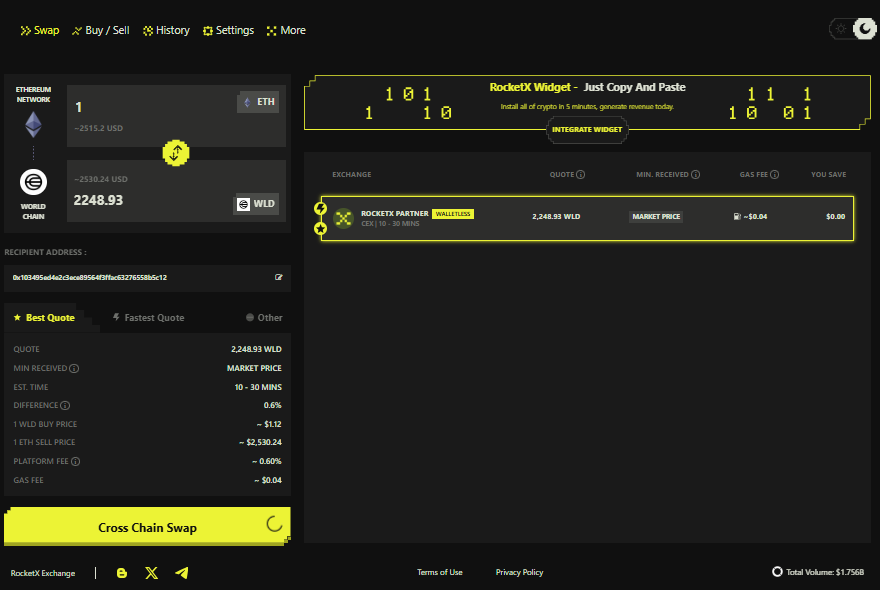
Step 6: Review and Confirm
Carefully review all the transaction details, including the network, token amount, fees, and recipient address.Once everything looks good, click “Cross Chain Swap” and approve the transaction in your wallet.
Step 7: Receive Your Tokens on World Chain
Your tokens will arrive in your World Chain wallet, typically within seconds or minutes, depending on network congestion and the speed of the source chain.
Once received, you can start using your assets across the World Chain ecosystem to:
- Interact with World Chain DeFi and dApps
- Participate in governance or identity-verified community programs
Pro Tip:
If you plan to use unverified wallets or deploy smart contracts, it’s a good idea to bridge a small amount of ETH along with your WLD to cover any gas-related edge cases. While verified World ID users enjoy free gas allowances, unverified wallets may require ETH for some interactions.
Network Stats, Challenges & World-Changing Opportunities
As of now, over 27.5 million people have created a World ID, with 12.83 million verified identities through the Orb biometric process. Daily active users surpass 1.37 million, while weekly and monthly figures stand at 4.36 million and 7.87 million, respectively, underscoring a rapidly growing, engaged community.
The World App wallet has become a cornerstone of the ecosystem, processing over 416 million transactions, with users collectively holding $126.3 million+ in assets. Vault yields have also crossed $2.25 million, showing a healthy financial layer evolving across the chain.
Challenges Faced by the World Chain
Despite this explosive growth, World Chain is not without its hurdles. One of the most debated topics is the use of biometric data, particularly iris scans, to generate World IDs. While Worldcoin insists that data is encrypted, stored locally, and users remain in control, the very concept has raised global privacy concerns. Gaining and maintaining user trust, especially in regions with strict data protection laws, will be critical.
With crypto laws evolving and governments skeptical about decentralized identity protocols, Worldcoin’s global expansion strategy might face legal roadblocks. Some countries have already paused operations until further review, which shows how delicate the balance between innovation and compliance can be.
A World of Opportunity
Yet, the opportunities that World Chain presents are massive. It’s the first blockchain designed with real humans in mind, and its protocol-level Proof-of-Personhood gives it an edge over few other networks. This enables use cases like:
- Bot-proof social networks, where every profile is a verified person
- Sybil-resistant DeFi and fairer token distributions
- Global financial inclusion through recurring WLD grants, acting as a crypto-native version of Universal Basic Income
- Decentralized governance based on identity, not just token ownership
- Privacy-respecting login systems that don’t compromise user data
Conclusion
World Chain represents more than just a technical upgrade to Ethereum—it’s a philosophical shift toward a more inclusive, identity-aware internet. By combining biometric identity through World ID with the scalability of Optimism’s OP Stack, World Chain is building a secure, Sybil-resistant Layer 2 that finally puts real people first. With features like free gas for verified users, human-prioritized transactions, and equitable governance models, it’s positioning itself as the infrastructure backbone for a more ethical and accessible Web3.
Despite challenges around privacy and regulation, its global traction, backed by millions of active users, dApps, and verified identities, proves there’s strong momentum behind this vision. Whether you’re a builder, trader, or everyday user, World Chain offers a chance to participate in a fairer, more human internet. And with RocketX Exchange simplifying access across chains, bridging to World Chain has never been easier. The world’s first human-focused blockchain is here—and it’s only getting started.


